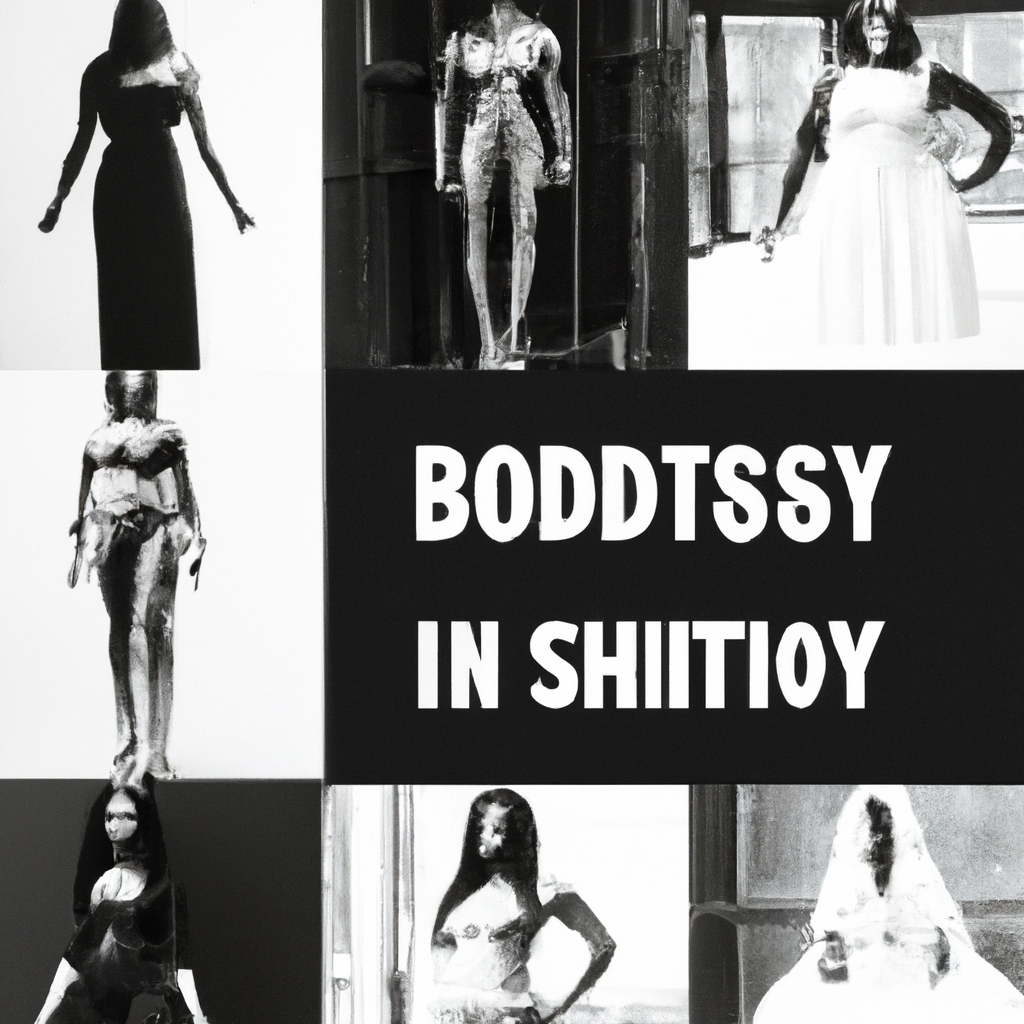Through the decades, fashion has been a reflection of society at large. It’s been a way to express our creativity, our uniqueness, and our changing values. And no issue has impacted fashion more than the cultural conversation around body positivity. From the days of cinched waists and restricted silhouettes, to the curves, colors, and comfort that reign in fashion today, let’s take a look at how body positivity has reshaped the fashion industry throughout the ages.
1. Unraveling the Evolution of Body Shapes in Fashion
Since the dawn of time, clothing has been a reflection of the fashion eras that preceded us. It is no secret that over the years, body shapes have evolved to reflect the wants and needs of the people wearing them. From bell-sleeved gowns of the Rococo era to the pleated trousers of the Edwardian period, fashion has evolved immensely and in different directions over the years. As such, it is important to take a closer look at some of the body shapes that have come and gone, and how they have impacted the fashion industry.
Three Dimensional Silhouettes
In the 17th century, women would often increase the volume of their skirts with many hoops and farthingales beneath. This exaggerated silhouette became a popular choice of the time. In the 19th century, the hourglass silhouette saw an increase in popularity, often seen in the corseted gowns of the day. With a tight bodice, fuller hips, and a defined waist, the hourglass was the ideal silhouette to show off a woman’s femininity.
Revolution of the Tubular Silhouette
The 1920s saw the end of the hourglass silhouette and the birth of the “tubular silhouette”. With its focus on flat chests, slender hips and straight legs, the “boyish” look became the ideal figure. The flattening of the silhouette continued throughout the 40s and 50s, and only began to see a change in the 1960s with the introduction of the iconic mini skirt. Fashion instantly changed, bringing shape back into the silhouette while maintaining the slim and slender figure.
The Millennial Impact
More recently, fashion has seen the rise of more inclusive silhouettes that flatter different body shapes, sizes, and ages. Millennial fashion has placed an emphasis on comfort and practicality while still remaining fashionable. Clothing such as sweatshirts, leggings, denim, and slip dresses have become staples of the modern wardrobe. The fashion industry has also strived to include more body shapes in its runways and campaigns, finally recognizing that fashion is for everyone.
From the three-dimensional silhouettes of the Rococo era to the more modern shapes of today, fashion has evolved and changed throughout the years. Society has opened its eyes to the fact that fashion is for all body shapes, sizes, and ages. The industry is in a state of continuous flux and the body shape evolution is not done yet.
2. Unbinding the Chains of the Corset: How Changing Ideals Shifted Silhouettes
For centuries, women had been confined to the restrictive structure of a corset in order to maintain a fashionable silhouette. While extremely painful to endure, the corset was seen as a symbol of being properly dressed, a sign of refinement and a moral compass. But tides changed quickly as the horizons of fashion broadened, and even in the late 19th century, there came a new revolution in women’s fashion.
Perhaps the most significant novelty of this period was how figures gradually shifted away from corsets and tightening waistlines to a more casual look, with a focus on freeing the figure and allowing for more movement and less restriction. With this, the fashion silhouette of women began to take on a more relaxed shape, with the woman’s upper half beginning to appear more voluminous and the lower half featuring a slimmer silhouette.
This movement eventually became known as the “unbinding of the corset” – a metaphor used to describe how clothing of the era aimed to empower women with the impression of freedom and independence. From the bold styling of the Gibson Girl to the modern shapes of the flapper dress, these silhouettes represented a new era in which women could make their own choices without having to be tied down tightly to any traditional beauty standards.
Particular garments of the time that reflected this shift included the “middy blouse” – a loose, sleeveless, collarless shirt featuring a wide band at the bottom covered in buttons from front to back. Moreover, hemlines began to rise, sleeves shrank and more emphasis was placed on relaxed yet feminine silhouettes.
- Gibson Girl – a new and modern beauty ideal for women embracing their femininity without sacrificing freedom
- Flapper dress – garments that were loose yet feminine and featured both modest and daring fashion choices
- Middy blouse – a loose, sleeveless shirt with a wide band at the bottom featuring buttons for decoration
The unbinding of the corset saw not only a change in fashion and silhouettes, but a shift in attitude towards the role of women in society. And while the 1920s marked the ideal of freedom for many, this period was just the beginning of a more progressive fashion movement for women.
3. Redefining Beauty: Giving Voice to Body Positivity
In today’s world, beauty is often considered a privilege, a too-often unattainable ideal. But embracing the concept of body positivity can help to rediscover what really matters when it comes to beauty. Let’s take a look at how to redefine beauty.
Practicing Self-Love
From prioritizing self-care and nurturing yourself with kindness, to treating exercise like medicine and nourishing your body with healthy, wholesome foods, self-love is an indispensable piece of the body positivity puzzle. Start small – take notice of your strengths, both physical and mental, and focus on your successes, no matter how small. Then consider how you can challenge yourself in a healthy way to reach those higher goals.
Celebrating Inner Beauty and Strength
Your beauty is more than just skin deep. Take a moment to reflect on your incredible inner strength and the power that’s innate within you. It’s truly mesmerizing when you make the conscious effort to focus on all the special things that make you unique – like the sound of your laughter, your heart and soul filled with creativity, and your unwavering determination to keep pushing forward and follow your dreams.
Inclusivity to the Max!
The world is often only presented with one type of beauty. It’s important to celebrate ourselves and those around us for their bodies, beauty, and unique differences. To redefine beauty means we must come together to create an inclusive environment for everyone to thrive in.
- Show compassion and kindness to all.
- Reach out to those in need.
- Lead by example.
Each of us has the potential to make a real difference in creating a more inclusive world that celebrates and values beauty in all forms.
4. Celebrating Style in All its Varied Forms: Embracing the Freedom of Individuality
Style is often thought of as something superficial, but, at its heart, it is about both self-expression and the exploration of our identities. Celebrating style in all its varied forms is an exercise in embracing individuality and the freedom it brings.
The Journey of Self-Exploration: From a young age, we are taught to judge and be judged for the way we look, dress, and act. We may develop a certain sense of style in an attempt to meet that superficial standard but, as we grow, this style should represent our self-expression and be unique to us. Celebrating style in all its forms allows us to break away from the expectations set upon us and instead, explore our identities through bold choices.
Breathing Life Into Our Wardrobes: Fashion is what makes the world spin and, if done right, can give you the opportunity to separate yourself from the rest. It allows us to represent ourselves in ways that may not have been available to us before. We can mix and match our favourite items and patterns, layer our clothing, or match unexpected colours, to basically create our own trend.
The More the Merrier: Celebrating style lends itself to appreciating the different customs and cultures that heavily influence fashion. From traditional clothing from far-off lands to everyday wear, no style is more superior than the other, because it all reflects how we choose to express ourselves.
Choosing to Celebrate: Celebrating style is about embracing the freedom of individuality. We all fall somewhere on the style spectrum and have something to offer and give to the world. It is time to challenge ourselves and be more inclusive, by appreciating styles and trends no matter their origin and how ‘odd’ or ‘unexpected’ they may be.
- Explore our identities through bold choices.
- Mix and match our favourite items and patterns.
- Appreciate styles and trends no matter their origin.
- Be inclusive and open-minded.
As one of the most awe-inspiring and overlooked aspects of modern fashion culture, body positivity is here to stay. Its weaving of both physical and emotional elements has revolutionized the silhouette of clothing—from corsets and bindings to looser, more comfortable figures. This shift has impacted the self-esteem of many across genders and generations, a powerful reminder that fashion isn’t only trends and aesthetics, but a message that speaks louder than words.

